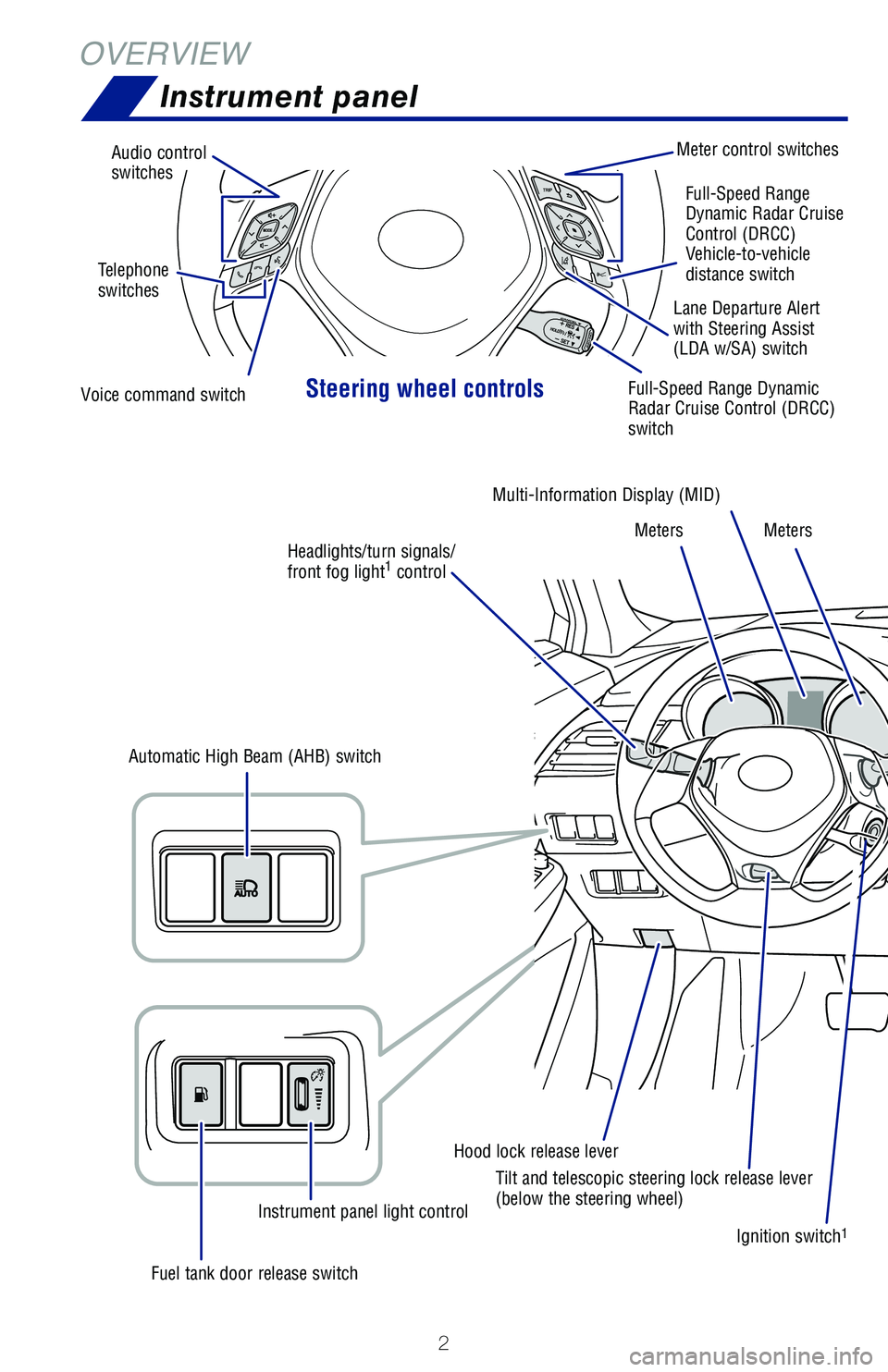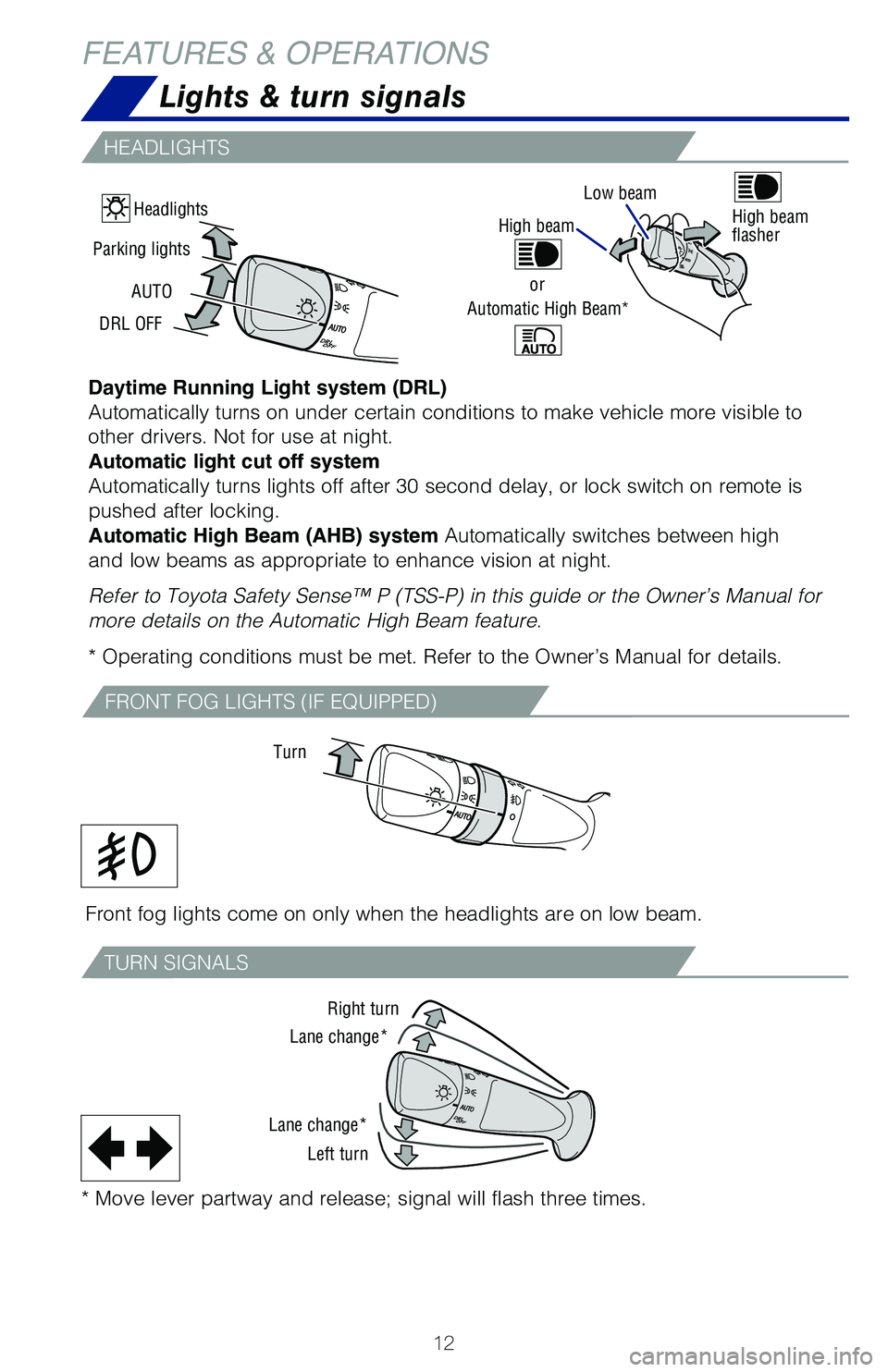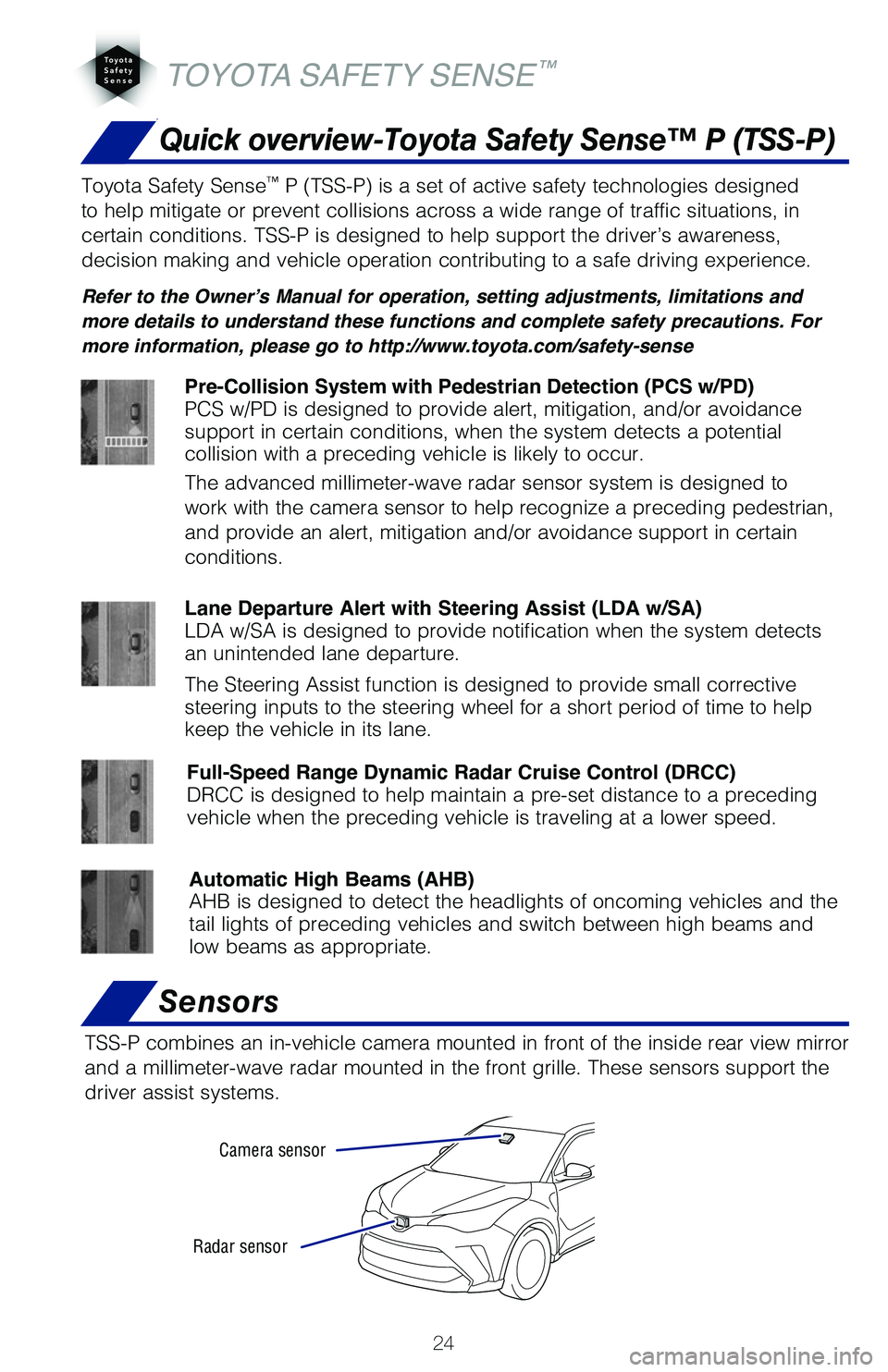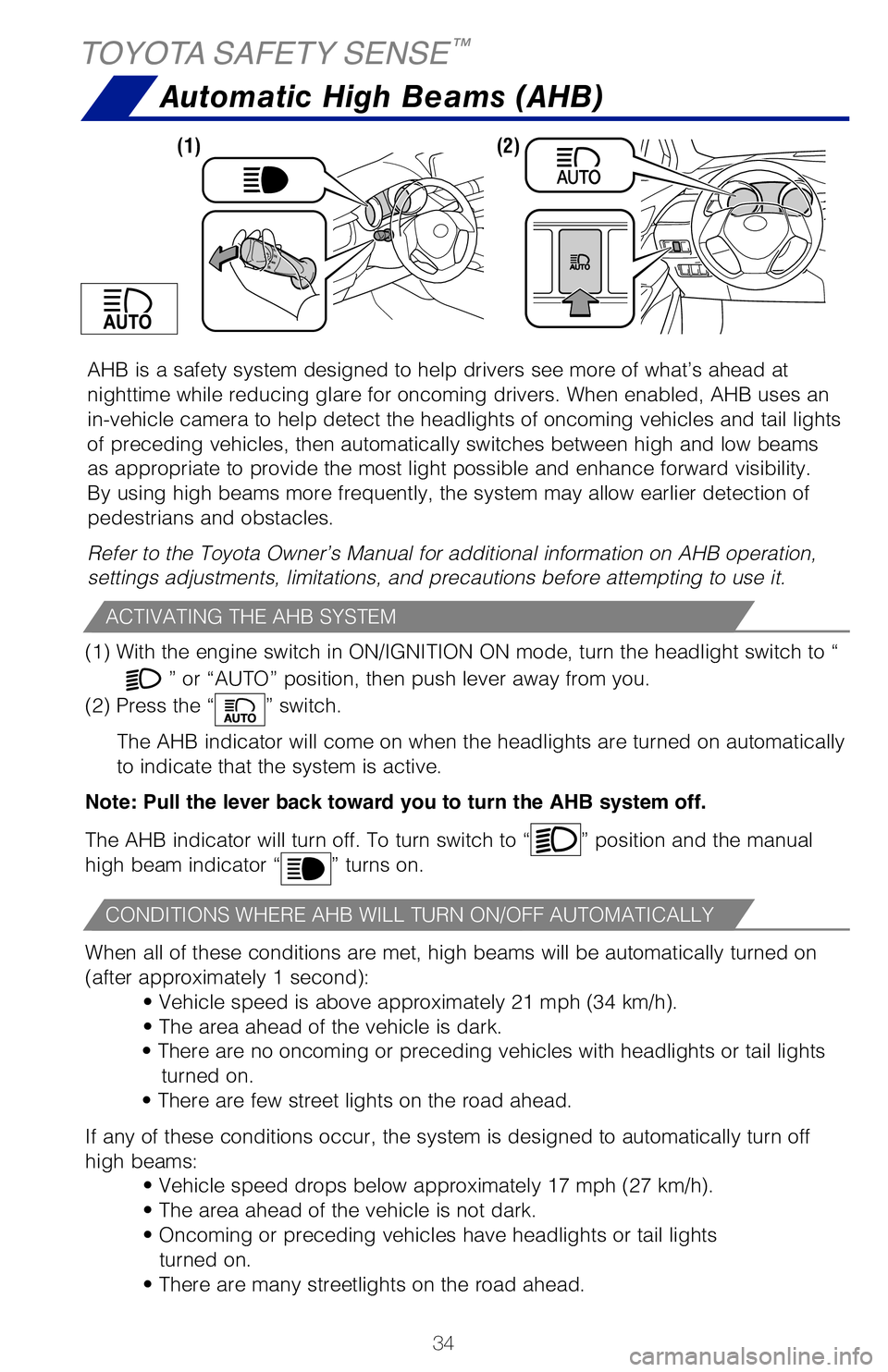headlights TOYOTA C-HR 2020 Owners Manual (in English)
[x] Cancel search | Manufacturer: TOYOTA, Model Year: 2020, Model line: C-HR, Model: TOYOTA C-HR 2020Pages: 48, PDF Size: 3.81 MB
Page 4 of 48

2
OVERVIEWInstrument panel
Steering wheel controls
Audio control
switches Meter control switches
Voice command switch Full-Speed Range Dynamic
Radar Cruise Control (DRCC)
switch
Ignition switch
1
Hood lock release leverMulti-Information Display (MID)
Meters Meters
Fuel tank door release switch Instrument panel light control
Automatic High Beam (AHB) switch
Tilt and telescopic steering lock release lever
(below the steering wheel)Full-Speed Range
Dynamic Radar Cruise
Control (DRCC)
Vehicle-to-vehicle
distance switch
Telephone
switches
Lane Departure Alert
with Steering Assist
(LDA w/SA) switch
Headlights/turn signals/
front fog light
1 control
Page 14 of 48

12
FEATURES & OPERATIONS
Daytime Running Light system (DRL)
Automatically turns on under certain conditions to make vehicle more visible to
other drivers. Not for use at night.
Automatic light cut off system Automatically turns lights off after 30 second delay, or lock switch on remote is
pushed after locking. Automatic High Beam (AHB) system Automatically switches between high
and low beams as appropriate to enhance vision at night.
Refer to Toyota Safety Sense™ P (TSS-P) in this guide or the Owner’s \
Manual for
more details on the Automatic High Beam feature.
* Operating conditions must be met. Refer to the Owner’s Manual for de\
tails.
High beam
or
Automatic High Beam*
Front fog lights come on only when the headlights are on low beam.
Turn
FRONT FOG LIGHTS (IF EQUIPPED)
Lights & turn signals
HEADLIGHTS
TURN SIGNALS
Right turn
Lane change*
Lane change* Left turn
* Move lever partway and release; signal will flash three times.
High beam
flasherHeadlights
Parking lights
DRL OFF AUTOLow beam
Page 26 of 48

24
Quick overview-Toyota Safety Sense™ P (TSS-P)
Sensors
TSS-P combines an in-vehicle camera mounted in front of the inside rear view \
mirror
and a millimeter-wave radar mounted in the front grille. These sensors supp\
ort the
driver assist systems.
Camera sensor
Radar sensor
TOYOTA SAFETY SENSE™
Toyota Safety Sense™ P (TSS-P) is a set of active safety technologies designed
to help mitigate or prevent collisions across a wide range of traffic situ\
ations, in
certain conditions. TSS-P is designed to help support the driver’s awareness\
,
decision making and vehicle operation contributing to a safe driving experience.\
Refer to the Owner’s Manual for operation, setting adjustments, limitations and
more details to understand these functions and complete safety precautions. For
more information, please go to http://www.toyota.com/safety-sense
Lane Departure Alert with Steering Assist (LDA w/SA)
LDA w/SA is designed to provide notification when the system detects
an unintended lane departure.
The Steering Assist function is designed to provide small corrective
steering inputs to the steering wheel for a short period of time to help
keep the vehicle in its lane.
Automatic High Beams (AHB)
AHB is designed to detect the headlights of oncoming vehicles and the
tail lights of preceding vehicles and switch between high beams and
low beams as appropriate.
Pre-Collision System with Pedestrian Detection (PCS w/PD)
PCS w/PD is designed to provide alert, mitigation, and/or avoidance
support in certain conditions, when the system detects a potential
collision with a preceding vehicle is likely to occur.
The advanced millimeter-wave radar sensor system is designed to
work with the camera sensor to help recognize a preceding pedestrian,
and provide an alert, mitigation and/or avoidance support in certain
conditions.
Full-Speed Range Dynamic Radar Cruise Control (DRCC)
DRCC is designed to help maintain a pre-set distance to a preceding
vehicle when the preceding vehicle is traveling at a lower speed.
Page 36 of 48

34
TOYOTA SAFETY SENSE™
Automatic High Beams (AHB)
AHB is a safety system designed to help drivers see more of what’s ahead\
at
nighttime while reducing glare for oncoming drivers. When enabled, AHB uses an
in-vehicle camera to help detect the headlights of oncoming vehicles and tail ligh\
ts
of preceding vehicles, then automatically switches between high and low be\
ams
as appropriate to provide the most light possible and enhance forward visi\
bility.
By using high beams more frequently, the system may allow earlier detectio\
n of
pedestrians and obstacles.
Refer to the Toyota Owner’s Manual for additional information on AHB opera\
tion,
settings adjustments, limitations, and precautions before attempting to use it.
(1) With the engine switch in ON/IGNITION ON mode, turn the headlight switc\
h to “
” or “AUTO” position, then push lever away from you.
(2) Press the “
” switch.
The AHB indicator will come on when the headlights are turned on automatica\
lly
to indicate that the system is active.
Note: Pull the lever back toward you to turn the AHB system off.
The AHB indicator will turn off. To turn switch to “
” position and the manual
high beam indicator “
” turns on.
When all of these conditions are met, high beams will be automatically turne\
d on
(after approximately 1 second): • Vehicle speed is above approximately 21 mph (34 km/h).
• The area ahead of the vehicle is dark.
• There are no oncoming or preceding vehicles with headlights or tail lig\
hts turned on.
• There are few street lights on the road ahead.
If any of these conditions occur, the system is designed to automatically \
turn off
high beams: • Vehicle speed drops below approximately 17 mph (27 km/h).
• The area ahead of the vehicle is not dark.
• Oncoming or preceding vehicles have headlights or tail lightsturned on.
• There are many streetlights on the road ahead.
ACTIVATING THE AHB SYSTEM
CONDITIONS WHERE AHB WILL TURN ON/OFF AUTOMATICALLY
(2) (1)